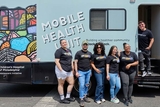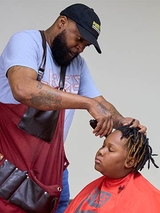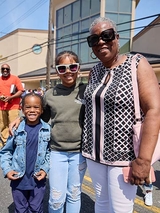
This is what the Center for Health Equity at Children’s Hospital of Philadelphia looks like in action: Hundreds of people of all ages flocked the 6100 block of Cedar Avenue in West Philadelphia, which had been transformed one Sunday in May into a street fair with a special purpose — supporting health equity.
Volunteers from CHOP and numerous other health and social service organizations staffed more than 20 booths related to all aspects of health. Attendees could learn CPR and how to stop bleeding from a serious wound, enroll in a peer support group to process grief, take home sports equipment or clothing suitable for a job interview, receive Narcan and training on how to use it, register for a library card, pitch a softball, get a haircut, be tested for sexually transmitted infections, learn a line dance and more. All for free.

It also looks like this:
Rose Singleton’s new gutters and roof: As part of the center’s Block Build program, homeowners in the Cobbs Creek neighborhood of West Philadelphia can apply to have exterior home repairs done for free to improve the overall neighborhood. “My roof was leaking, and water was getting behind the siding, too. They fixed it all,” Singleton says. “It was zero cost to me. I’m overjoyed that CHOP would help me.”
It also looks like this:
CHOP employee Karen Topping serving on the Neighborhood Council: Topping, a project operations manager for the Bioengineering Department, has lived in West Philadelphia her whole life and, along with seven other council members, acts as the center’s eyes and ears in the neighborhoods. “I can give a perspective that people who don’t live here — no matter how well intentioned they are — just don’t have,” she says. “CHOP understands that communication can’t be one way, and I feel like I can make a difference.” Topping represented the center at a mayoral candidate forum before the primary election, hosted by the Community of Compassion Community Development Corp. (COC CDC).

It also looks like this:
Community health navigator Paige Prince providing resources to the Taylor family: Romeo, 3, a patient at the CHOP Care Network Cobbs Creek Primary Care practice, has a rare genetic condition that has caused developmental delays, severe vision problems and autism. “He’s not speaking, and he can only take a couple of steps,” says his mother, Maria, who focuses her time on the needs of Romeo and her other children. Price has connected the family with resources to help with utility bills and with two Philadelphia agencies that provide families with a handicapped member home renovations to accommodate limited mobility needs. “There are nine steps to get into our house,” Maria says. “Romeo is almost 35 pounds. Pretty soon I won’t be able to lift him anymore. This help will allow us to stay in our home.”
And it looks like this:
Building trust between CHOP and Cobbs Creek residents: “Community members tell us they are so grateful that CHOP comes to us,” says Pastor Terrilynn Donnell, Executive Director of the COC CDC, a key CHOP partner and host of the quarterly health partnership clinics. “Everything is always about building relationships, building trust. They tell us because CHOP comes to the Community of Compassion and we trust them, that they can trust CHOP. Our partnership is priceless. I’m so glad that together we’re able to do this for our community.”
Using a health equity lens

One aspect of the mission of the Center for Health Equity (CHE), which is entering its third year, is to work with community members to identify where health disparities exist and find ways to eliminate them. But there is more. The center is charged with examining all aspects of the CHOP enterprise through a health equity lens and correcting areas that show bias, inequality, racial discrimination or unfairness.
It’s a challenge, but with the endorsement of top leadership and driven by Chief Health Equity Officer Tyra Bryant-Stephens, MD, CHOP is steering Philadelphia in the right direction.
“I truly believe that when Children’s Hospital of Philadelphia partners with others to address the root causes for health disparities, we can achieve health equity,” says Bryant-Stephens. “My vision is to implement strategies so every child in Philadelphia has what they need to achieve their best health.”

The needs in Philadelphia — the poorest of the 10 largest U.S. cities — are so great, CHE currently focuses its efforts on initiatives to reduce disparities in four clinical areas: trauma, asthma, behavioral health and infant morbidity/mortality. In addition, it also concentrates on four social determinants: healthcare access, economic stability, neighborhood and built environment, and social/community context. The first target area for CHE’s work is the Cobbs Creek neighborhood.
Clinical and research outcomes
While many of the strategies employed by CHE are community-based, others start within the hospital. One is the REaL Data Capture Quality Improvement Project. This effort seeks to ensure that every CHOP patient has their race, ethnicity and language preference listed consistently in the electronic medical record. It is the only way for researchers and clinicians to tease out whether diagnosis and treatment are free of race-based inequities.
The Center for Health Equity doesn’t conduct its own research but serves as a resource to help CHOP’s research scientists ensure their studies include measurements that are inclusive and equitable. With CHE’s guidance, the inclusive/equitable standard is now part of how CHOP frames improvements in patient access and care. For example, as the hospital was developing a new policy around missed appointments, it expanded its view to consider socioeconomic hurdles such as lack of transportation or the inability for a parent to miss work as part of the strategy.
“We need to ensure that interventions and policies are reducing disparities and not creating or worsening them,” Bryant-Stephens says. When research shows an intervention reduces disparities for CHOP patients and families, the goal is to replicate it across Philadelphia and beyond.
Assurance that new interventions reduce disparities is critical, as the medical establishment has historically moved at a glacial pace to address long-known racism-based differences in access, treatments and outcomes.
Case in point: infant deaths
Consider the data that shows Black babies die before their first birthday at more than twice the rate of white babies (10.8 per 100,000 as compared to 4.6, according to the Centers for Disease Control and Prevention). Even as the infant mortality rate in the United States has improved overall (dropping from 9.2 per 100,000 in 1990 to 5.6 in 2020), it remains stubbornly high for Black children.
“It’s one thing to know the disparities exist,” Bryant-Stephens says. “Now we have to do something about it.”
Two CHE programs are in the works to specifically address the infant mortality racial disparity.
One is the Teen-Infant Clinic, which seeks to reduce health disparities in infant illnesses by providing vital primary care services to teenage mothers and their babies in the same appointment, while also connecting them to social support systems that can set them up to graduate from high school and become economically independent adults.
Another is a partnership with the Philadelphia Department of Health and other nonprofit organizations to create the Philly Joy Bank, a pilot program that would provide pregnant and new mothers a no-strings-attached check for $1,000 a month for 18 months, beginning in the second trimester and extending through the baby’s first year.
“It will allow pregnant mothers to take time off to go to their OB-GYN appointments or well-baby visits, or pay their rent, or buy diapers, or go to school so they qualify for a better-paying job — whatever they need to improve their situations,” Bryant-Stephens says. “Health outcomes for the mother and baby will be tracked so we will be able to say, ‘Do you know what? When mothers can put a roof over their heads and care for their babies, it’s better for the kids’ health.’”
Committed for the long haul

Securing health equity for Philadelphia’s children — and for all children — will not be easy and will not be quick.
“We are committed because we know this is the right thing to do,” says Bryant-Stephens. “The strength of CHOP combined with the power of our partners in the community will keep us moving forward until our children are the healthiest in the nation and the color of their skin won’t matter.”
To find out how you can support the Center for Health Equity, contact Chris Major at majorc@chop.edu.
Featured in this article
Specialties & Programs
This is what the Center for Health Equity at Children’s Hospital of Philadelphia looks like in action: Hundreds of people of all ages flocked the 6100 block of Cedar Avenue in West Philadelphia, which had been transformed one Sunday in May into a street fair with a special purpose — supporting health equity.
Volunteers from CHOP and numerous other health and social service organizations staffed more than 20 booths related to all aspects of health. Attendees could learn CPR and how to stop bleeding from a serious wound, enroll in a peer support group to process grief, take home sports equipment or clothing suitable for a job interview, receive Narcan and training on how to use it, register for a library card, pitch a softball, get a haircut, be tested for sexually transmitted infections, learn a line dance and more. All for free.

It also looks like this:
Rose Singleton’s new gutters and roof: As part of the center’s Block Build program, homeowners in the Cobbs Creek neighborhood of West Philadelphia can apply to have exterior home repairs done for free to improve the overall neighborhood. “My roof was leaking, and water was getting behind the siding, too. They fixed it all,” Singleton says. “It was zero cost to me. I’m overjoyed that CHOP would help me.”
It also looks like this:
CHOP employee Karen Topping serving on the Neighborhood Council: Topping, a project operations manager for the Bioengineering Department, has lived in West Philadelphia her whole life and, along with seven other council members, acts as the center’s eyes and ears in the neighborhoods. “I can give a perspective that people who don’t live here — no matter how well intentioned they are — just don’t have,” she says. “CHOP understands that communication can’t be one way, and I feel like I can make a difference.” Topping represented the center at a mayoral candidate forum before the primary election, hosted by the Community of Compassion Community Development Corp. (COC CDC).

It also looks like this:
Community health navigator Paige Prince providing resources to the Taylor family: Romeo, 3, a patient at the CHOP Care Network Cobbs Creek Primary Care practice, has a rare genetic condition that has caused developmental delays, severe vision problems and autism. “He’s not speaking, and he can only take a couple of steps,” says his mother, Maria, who focuses her time on the needs of Romeo and her other children. Price has connected the family with resources to help with utility bills and with two Philadelphia agencies that provide families with a handicapped member home renovations to accommodate limited mobility needs. “There are nine steps to get into our house,” Maria says. “Romeo is almost 35 pounds. Pretty soon I won’t be able to lift him anymore. This help will allow us to stay in our home.”
And it looks like this:
Building trust between CHOP and Cobbs Creek residents: “Community members tell us they are so grateful that CHOP comes to us,” says Pastor Terrilynn Donnell, Executive Director of the COC CDC, a key CHOP partner and host of the quarterly health partnership clinics. “Everything is always about building relationships, building trust. They tell us because CHOP comes to the Community of Compassion and we trust them, that they can trust CHOP. Our partnership is priceless. I’m so glad that together we’re able to do this for our community.”
Using a health equity lens

One aspect of the mission of the Center for Health Equity (CHE), which is entering its third year, is to work with community members to identify where health disparities exist and find ways to eliminate them. But there is more. The center is charged with examining all aspects of the CHOP enterprise through a health equity lens and correcting areas that show bias, inequality, racial discrimination or unfairness.
It’s a challenge, but with the endorsement of top leadership and driven by Chief Health Equity Officer Tyra Bryant-Stephens, MD, CHOP is steering Philadelphia in the right direction.
“I truly believe that when Children’s Hospital of Philadelphia partners with others to address the root causes for health disparities, we can achieve health equity,” says Bryant-Stephens. “My vision is to implement strategies so every child in Philadelphia has what they need to achieve their best health.”

The needs in Philadelphia — the poorest of the 10 largest U.S. cities — are so great, CHE currently focuses its efforts on initiatives to reduce disparities in four clinical areas: trauma, asthma, behavioral health and infant morbidity/mortality. In addition, it also concentrates on four social determinants: healthcare access, economic stability, neighborhood and built environment, and social/community context. The first target area for CHE’s work is the Cobbs Creek neighborhood.
Clinical and research outcomes
While many of the strategies employed by CHE are community-based, others start within the hospital. One is the REaL Data Capture Quality Improvement Project. This effort seeks to ensure that every CHOP patient has their race, ethnicity and language preference listed consistently in the electronic medical record. It is the only way for researchers and clinicians to tease out whether diagnosis and treatment are free of race-based inequities.
The Center for Health Equity doesn’t conduct its own research but serves as a resource to help CHOP’s research scientists ensure their studies include measurements that are inclusive and equitable. With CHE’s guidance, the inclusive/equitable standard is now part of how CHOP frames improvements in patient access and care. For example, as the hospital was developing a new policy around missed appointments, it expanded its view to consider socioeconomic hurdles such as lack of transportation or the inability for a parent to miss work as part of the strategy.
“We need to ensure that interventions and policies are reducing disparities and not creating or worsening them,” Bryant-Stephens says. When research shows an intervention reduces disparities for CHOP patients and families, the goal is to replicate it across Philadelphia and beyond.
Assurance that new interventions reduce disparities is critical, as the medical establishment has historically moved at a glacial pace to address long-known racism-based differences in access, treatments and outcomes.
Case in point: infant deaths
Consider the data that shows Black babies die before their first birthday at more than twice the rate of white babies (10.8 per 100,000 as compared to 4.6, according to the Centers for Disease Control and Prevention). Even as the infant mortality rate in the United States has improved overall (dropping from 9.2 per 100,000 in 1990 to 5.6 in 2020), it remains stubbornly high for Black children.
“It’s one thing to know the disparities exist,” Bryant-Stephens says. “Now we have to do something about it.”
Two CHE programs are in the works to specifically address the infant mortality racial disparity.
One is the Teen-Infant Clinic, which seeks to reduce health disparities in infant illnesses by providing vital primary care services to teenage mothers and their babies in the same appointment, while also connecting them to social support systems that can set them up to graduate from high school and become economically independent adults.
Another is a partnership with the Philadelphia Department of Health and other nonprofit organizations to create the Philly Joy Bank, a pilot program that would provide pregnant and new mothers a no-strings-attached check for $1,000 a month for 18 months, beginning in the second trimester and extending through the baby’s first year.
“It will allow pregnant mothers to take time off to go to their OB-GYN appointments or well-baby visits, or pay their rent, or buy diapers, or go to school so they qualify for a better-paying job — whatever they need to improve their situations,” Bryant-Stephens says. “Health outcomes for the mother and baby will be tracked so we will be able to say, ‘Do you know what? When mothers can put a roof over their heads and care for their babies, it’s better for the kids’ health.’”
Committed for the long haul

Securing health equity for Philadelphia’s children — and for all children — will not be easy and will not be quick.
“We are committed because we know this is the right thing to do,” says Bryant-Stephens. “The strength of CHOP combined with the power of our partners in the community will keep us moving forward until our children are the healthiest in the nation and the color of their skin won’t matter.”
To find out how you can support the Center for Health Equity, contact Chris Major at majorc@chop.edu.
Contact us
Center for Health Equity